פרסומים
November 05, 2013
Water Policy in Israel
Global Issues in Water Policy Volume 4
Nir Becker, ed.
This book deals with water policy in Israel. It offers a detailed examination of the main sources of Israel's water, its principle consumers, the gap between supply and demand, and the complex, contentious work of analyzing and devising the nation's water management and use policies.
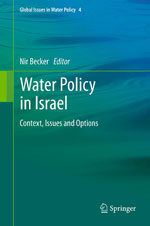 Water Policy in Israel is arranged in five broad sections: The dynamics of moving from one policy era to another; Supply management; Demand management; The importance of the Sea of Galilee and the Dead Sea; and Regional and global issues including water conflict and cooperation and climate change.
Water Policy in Israel is arranged in five broad sections: The dynamics of moving from one policy era to another; Supply management; Demand management; The importance of the Sea of Galilee and the Dead Sea; and Regional and global issues including water conflict and cooperation and climate change.
Expert contributors discuss such topics as the history of Israel's water policy, and the reasoning which explains long periods of policy stalemate, especially in situations where the risks generated by prolonged impasse are obvious. Other chapters describe efforts to meet agricultural demand for water by augmenting supplies with groundwater management, waste water re-use and desalination. The impact of climate change is discussed, along with the international dimensions of water policy, including many examples of conflict and cooperation between Israel and its neighbors, the Arab-Israeli conflict and possible areas of cooperation and conciliation. The last two chapters include a review of the last reforms initiated by the Israeli Water Authority in light of the foregoing issues which is followed by the last chapter, presenting the editor's assessment and conclusions.
Chapter 15- Basin Management in the Context of Israel and the Palestine Authority
By Richard Laster and Dan Livney
Abstract
Preparation of a master plan for a transboundary watercourse serves as a touchstone for cooperation between two conflicting entities. It enables decision making under any scenario: coexistence, cooperation, or partnership. It weighs the value of each scenario and allows policy makers to make decisions based on value judgments. It improves tools for grassroots democracy, stakeholder involvement, and collaborative decision making (heterarchy). In the worse case, it serves as a platform for discussion instead of acrimony; in the best case, a platform for cooperative river restoration, improved planning, and increased biological diversity. In this chapter we demonstrate implementation of such master plan for such a trans boundary river in Israel and the Palestinian Authority.
January 28, 2013
Environmentalists tap Palestinian schoolchildren to clean Jerusalem's holy valley
Six Olympic-size pools of trash and sewage are dumped in Kidron Valley, which abuts Jerusalem's holiest sites, every year
Click here to read this article
January 28, 2013
The Kidron Valley/Wadi Nar Master Plan Project Haaretz Article
Bridge over dirty water-Haaretz article
April 28, 2012
The Kidron Valley/Wadi Nar Master Plan Project
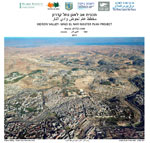
The Kidron Valley/Wadi Nar begins in the Jerusalem neighbourhoods of Meah Shaarim and Talbieh, skirts the ridges of Mount Scopus and the Mount of Olives, passes through Silwan and continues through the Judean Desert to the Dead Sea. Some of the Middle East’s most famous cultural, religious and historic sites dwell in harmony in the valley, along with underground watercourses, monasteries and breathtaking desert landscapes.
Unchecked development and neglect, however, together with an increase in population, has had major health, environmental, and economic consequences. Today one of the great centres of civilization serves as a conduit for raw sewage and a depositary of solid waste.
In 2009 the Dead Sea Drainage and River Authority decided to meet the challenge, and with the City of Jerusalem, set up a steering committee including representatives from the Ministry of Environment, the Peres Center for Peace, the Jerusalem Institute for Israel Studies and the Milken Institute to oversee the development of a Kidron Valley Master Plan. The steering committee is chaired by Professor Richard Laster.
The Master Plan, developed by a multi-disciplinary team of experts, was completed in January 2012. It identifies the issues, concerns and problems of the Kidron Valley/Wadi Nar and recommends solutions. A master plan, based on ecological, historical, physical, economic and geographical terms agreed upon by both sides will serve the best interests of the Valley, regardless of present or future political sovereignty issues. There is no alternative to collective action when managing a shared international basin. Nature, ecosystems and the intricate interaction between water, climate, soil, flora, fauna and people can only be protected by collective action.
The major beneficiaries of the Master Plan are the Valley residents themselves, both the citizens of Jerusalem, Bethlehem, Ubadiya and the other towns in the region, as well as the region's Bedouin and monks. Improved planning, land usage and infrastructure will convert the Kidron Valley/Wadi Nar from the back door of history to its rightful place as a showcase for residents and visitors alike.
The Master Plan steering committee has now begun the implementation process, selecting projects which will jumpstart physical improvements as well as positive changes in the perceptions of the residents.
Kidron valley master plan flyer
Kidron valley master plan official website
November 12, 2011
Kidron master plan article
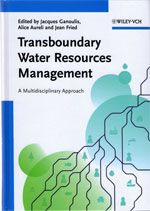
This book aims to serve as a practical guide for collaborative actions in Transboundary Water Resources Management (TWRM), and includes the latest developments in methodological tools, illustrated by practical case studies from around the world. On a national basis, water resources management is a complex issue mainly of water sharing and conflict resolution between different national administrations and various stakeholders. When waters cross international borders thus becomes even more challenging.
International guidelines and programmes are analysed, such as the UNESCO Internationally Shared Aquifer Resources Management (UNESCO-ISARM) initiative, UNESCO Potential Conflict to cooperation Potential (PCCP) programme, and the EU Water Framework Directive (EU-WFD) 2000/60. Practical tools, state-of-the-art methodologies and models for TWRM from different parts of the world are also provided, showing how to deal with data sharing, water scarcity, climate change, water related conflicts, enhance stakeholder participation and incorporate socio-economic issues. This will be very useful not only to engineers, hydrologists and hydrogeologists but also to lawyers, social and political scientists, decision makers, graduate students and researchers interested in TWRM.
August 10, 2011
נחלים וניקוז- תהליכים, הנדסה ותכן
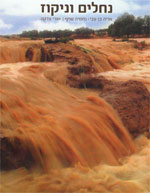
ספר זה מאסף מאמרים על תהליכים בנחלים, הנדסה ותכן הקשורים לניקוז נגר על-קרקעי בשטחים פתוחים. מטרתו להציג בתמצית את הידע הנדרש לעבודתם של מהנדסי ניקוז ולסייע בביצוע נאות של מטלותיהם.
"ניקוז, סחף קרקע ונחלים: המסגרת המשפטית והמנהלית" מאת ראובן לסטר, דני לבני ואריאלה גרינברג. פרק 20 עמ' 321,
מאמר זה מתאר את המערכת התחיקתית, אשר משמשת מדברת לטיפול בנגר עילי, נחלים, ואדיות ואגמים. כן מתוארת המערכת המנהלית, שהוקמה על בסיס המסגרת המשפטית, כדי לאכוף מדיניות ממשלתית לניהול מערכות ניקוז
May 05, 2011
Environmental Law in Israel
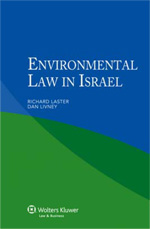
Derived from the renowned multi-volume International Encyclopaedia of Laws, this book provides ready access to legislation and practice concerning the environment in Israel.
A general introduction covers geographic considerations, political, social and cultural aspects of environmental study, the sources and principles of environmental law, environmental legislation, and the role of public authorities.
The main body of the book deals first with laws aimed directly at protecting the environment from pollution in specific areas such as air, water, waste, soil, noise, and radiation. Then, a section on nature and conservation management covers protection of natural and cultural resources such as monuments, landscapes,
parks and reserves, wildlife, agriculture, forests, fish, subsoil, and minerals. Further treatment includes the application of zoning and land-use planning, rules on liability, and administrative and judicial remedies to environmental issues. There is also an analysis of the impact of international and regional legislation
and treaties on environmental regulation.
Its succinct yet scholarly nature, as well as the practical quality of the information it provides, make this book a valuable resource for environmental lawyers handling cases affecting Israel. Academics and researchers, as well as business investors and the various international organizations in the field, will welcome this very useful guide, and will appreciate its value in the study of comparative environmental law and policy.
April 27, 2010
Social Participation In Water Governance And Management
Social participation in water management and governance recently became a reality in many economies and societies. Yet the dimensions in which power regulation, social equity and democracybuilding are connected with participation has been only tangentially analyzed for the water sector.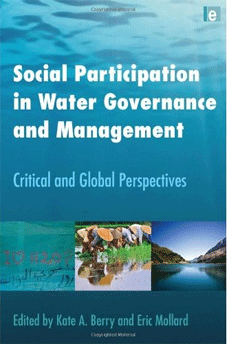
Understanding the growing interest in social participation involves appreciating the specificity of the contemporary period within its historic and geographic contexts as well as uncovering larger political, economic and cultural trends of recent decades which frame participatory actions. Within a wide variety of cases presented from around the world, the reader will find critical analyses of participation and an array of political ecological processes that influence water governance.
Sixteen chapters from a diverse group of scholars and practitioners examine water rights definition, hydropower dam construction, urban river renewal, irrigation organizations, water development NGOs, river basin management, water policy implementation and judicial decision-making in water conflicts.Yet there are commonalities in participatory experiences across this spectrum of water issues.
The book's five sections highlight key dimensions of contemporary water management that influence, and in turn are influenced by, social participation. These sections are: participation and indigenous water governance; participation and the dynamics of gender in water management; participation and river basin governance; participation and implementation of water management and participation and the politics of water governance
Social Participation In Water Governance And Management: Critical And Global Perspectives synopsis
Chapter 11 - The Public's Role as a Stakeholder in the Yarqon River Authority, Israel
June 18, 2009
ים המלח הנעלם: כשל מערכתי בניהול אגם בינלאומי מן ההיבט המשפטי
בטרם מתפנים לקריאת החוברת ים המלח הנעלם ייטיבו הקוראים לעשות אם יעיינו גם בהרפתקאות אליסיה בארץ הפלאות. בהשראת ספרו הנפלא של לויס קרול אפשר להבין כיצד מנהלת המדינה משאב טבע שהוא מורשת עולמית.
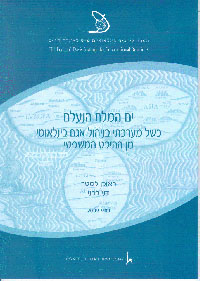 “Just look along the road, and tell me if you can see either of them”
“Just look along the road, and tell me if you can see either of them”
“I see nobody on the road”, said Alice.
“I only wish I had such eyes”, the King remarked in a fretful tone. “To be able to see Nobody! And at that distance, too!".
Lewis Carroll, Through the Looking Glass
ייחודו של ים המלח ומיקומו הגיאוגרפי והפוליטי מחייבים מערכת משפטית ומנהלית ייחודית להגנתו. כיצד אפשר לשמור על אוצר טבע ייחודי באמצעות שש מערכות משפט: הדין הישראלי, הירדני, הפלסטיני, הצבאי והבינלאומי?
מאמר זה מתאר את הזעזועים הפוקדים את ים המלח לנוכח מערכת משפטית שאינה מלוכדת דייה להושיט עזרה לים. החוקרים מתמודדים עם שאלות שאחרים חוששים לעלות: האם התדרדרות המצב נובעת מהזנחה או ממדיניות מיושנת וקלוקלת? האם הממשלה רשאית להעדיף מגזר אחד של המדינה לצורך אספקת מים כאשר מגזר אחר משלם את נזקי ההעדפה? מדוע ניתן זיכיון של 3% משטח המדינה לחברה פרטית בלי לחייבה לעמוד בסטנדרטים סביבתיים בינלאומיים? כיצד מיישמת ישראל את עקרונות הדין הבינלאומי בים המלח?
בעמודים האחרונים של המאמר מוצגות מפת דרכים והמלצות לפעולה.
June 17, 2009
The Evolution of the Law and Politics of Water
The Evolution of the Law and Politics of Water presents an overview of global trends in water law and policy and  assesses current global water governance. It provides an historic understanding of how and why after 5,000 years of water governance, that governance still has not reached stability. It identifies the key research questions for water law and policy while providing an overview of the current global water governance regime, its evolving characteristics, and the legal theories involved in these changes. It focuses on water law and discusses the characteristics of national, supranational, and international water law through a combination of case studies and thematic chapters.
assesses current global water governance. It provides an historic understanding of how and why after 5,000 years of water governance, that governance still has not reached stability. It identifies the key research questions for water law and policy while providing an overview of the current global water governance regime, its evolving characteristics, and the legal theories involved in these changes. It focuses on water law and discusses the characteristics of national, supranational, and international water law through a combination of case studies and thematic chapters.
Dani Livni and Richard Laster took part in this project, and contributed two chapters.
April 10, 2009
Environment, Administration, and Law in Israel:
Part A - The Roots of Environmental Law and Administration in Israel
Download Article - Part A
part B - The central administration
Download Article - Part B
Part C - Government Ministries
Download Article - Part C
April 10, 2009
Water Flowing Under the Law: The Role of Water Law in the Planning and Management of a Sustainable Water Supply for the Middle East
Download Article
April 10, 2009
Using Indirect Legislation to Protect Open Spaces and Farmland
Download Article
April 10, 2009
תיקון חוק הגנת השכר 1958
Download ArticleApril 10, 2009
חקיקה חדשה בנושא איכות הסביבה ובריאות
Download ArticleApril 10, 2009

